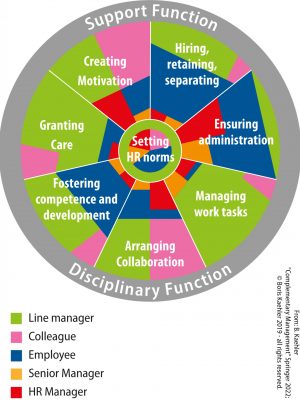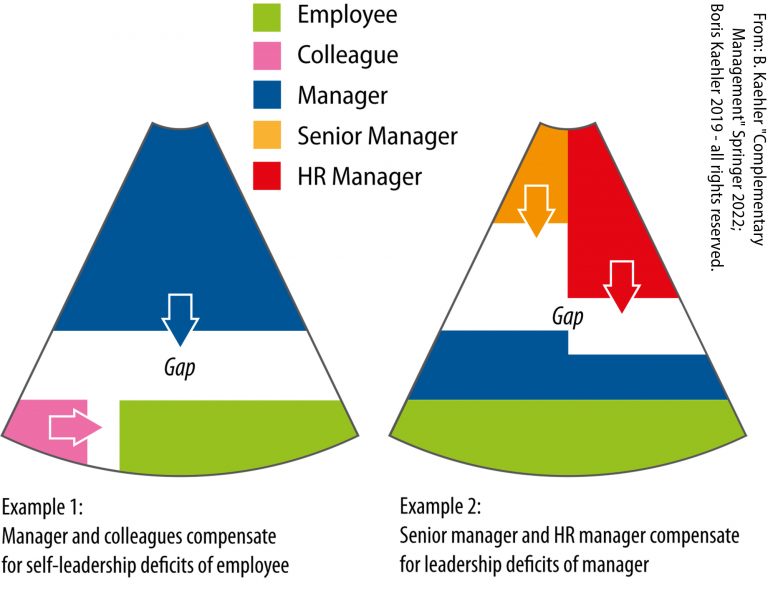The Core Model
The core model of Complementary Management addresses the fundamental aspects and mechanisms of people management and leadership in organizations.
Synopsis of the Three Core Elements
The core model of Complementary Leadership contains the fundamental aspects and mechanisms of people management and leadership in organizations. It describes them as a bundle of 24 tasks in which two functions take form and which are accomplished by five main actors. The core model of Complementary Management thus describes people management and leadership as a bundle of 24 tasks in which two service functions incorporate themselves and which are accomplished by five main actors. With these three core elements, it forms a counter-concept, so to speak, to the widespread idea of leadership as a personality-based or systemic relationship phenomenon (= in which there is a lack of clearly defined leadership/management tasks) brought about by line managers (= in which there is a lack of other actors) which confers on them a reign-like self-image (= in which the idea of service is lacking).
Complementary Management Functions: Leadership as a Service
The first element of the core model consists of the complementary management functions. Organizational people management and leadership are understood to be an internal service. This service has two functions with respect to the personnel in an organizational unit. The support function is to help individual employees perform their jobs. The catchwords “to foster”, “appreciation” and “employee orientation” illustrate this. The disciplinary function is to discipline and supervise the performance of individual employees. The catchwords here are “to demand”, “added value” and “production orientation”. In terms of management and leadership theory, the model element thereby ties in with the approach of “management as a service” and the classic duality of “employee orientation” vs. “production orientation”. It has the status of a fundamental principle and is primarily of practical value: The idea of management as a dual service provides orientation for line managers and prevents destructive management and leadership.
Complementary Management Tasks: Leadership as a Bundle of Tasks
The complementary management tasks form the second model element. People management and leadership consists of 24 tasks that can be grouped into eight categories: “Setting HR norms,” “Hiring, retaining, separating,” “Ensuring administration,” “Managing work tasks,” “Arranging collaboration,” “Fostering competence and development,” “Granting care,” and “Crafting motivation”. This is based on the premise that precisely these influences are required to generate sustainable human performance. The model is thus in the theoretical tradition of normative task models of leadership and management. However, the management tasks are not understood as activities, but as abstract goals to be realized within the framework of concrete activities (“management routines”, see below). All 24 tasks together complement each other to form the overall task of people management and leadership. In each task, both the disciplinary and the support function are specified.
Complementary Management Actors: Management and Leadership as Shared Leadership
The third element of the core model encompasses the complementary management actors. People management and leadership is the responsibility of several key players: the employee, his or her colleagues, the line manager, the senior manager and the HR advisor. The primary management principle should be self-management, i.e., the employee should ideally take on all leadership/management tasks him or herself. Since not all employees always do this, the line-manager must intervene in a compensatory manner when necessary. If he or she does not, it is up to the senior manager and the HR advisor acting as “co-HR manager” to intervene in a compensatory manner. These interventions can be corrective, joint, delegative or substitutive. The complementary actors thus complement each other and collectively perform the 24 management tasks. This compensatory mechanism ensures, on the one hand, that all management tasks are actually performed with regard to each individual employee even if the line manager is inactive, thus ensuring that work is performed. On the other hand, this multi-entity system is suitable for preventing an abuse of power by the line manager. In terms of management and leadership theory, the element of complementary management actors takes up the “Shared Leadership” approach, which is combined with the concept of self-management and with a vertical-hierarchical exercise of authority based on the principle of exception.


